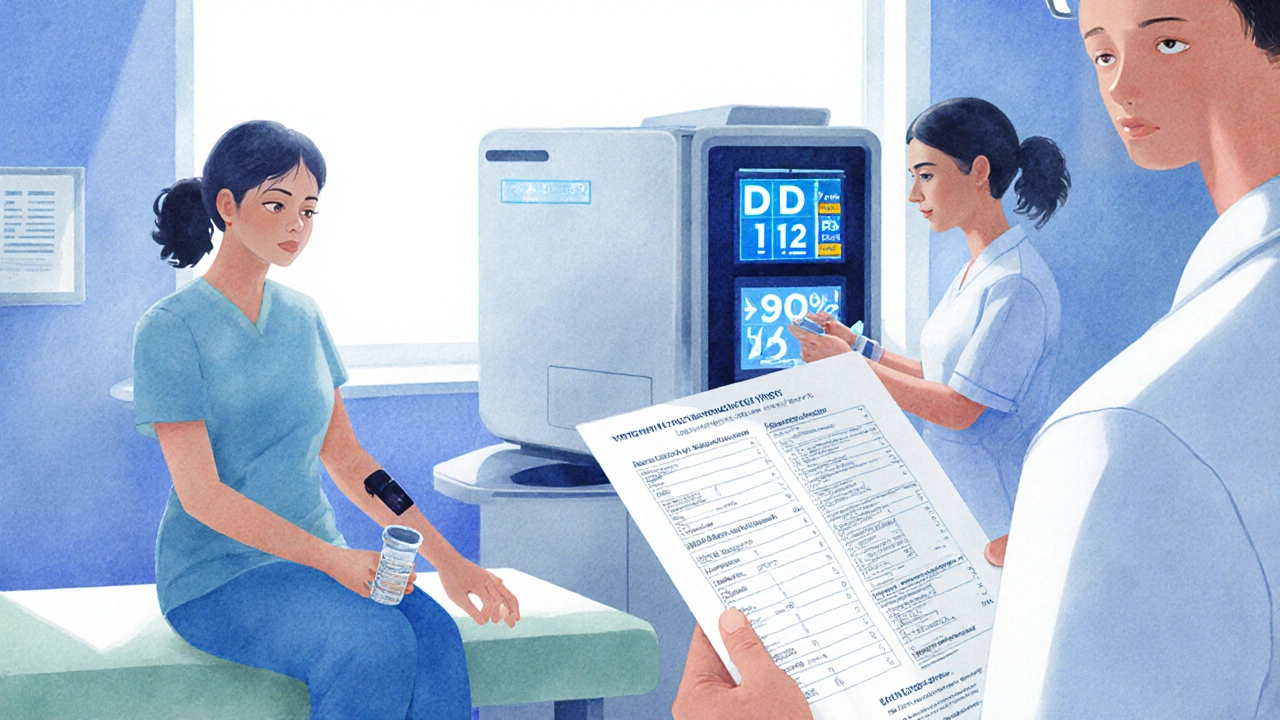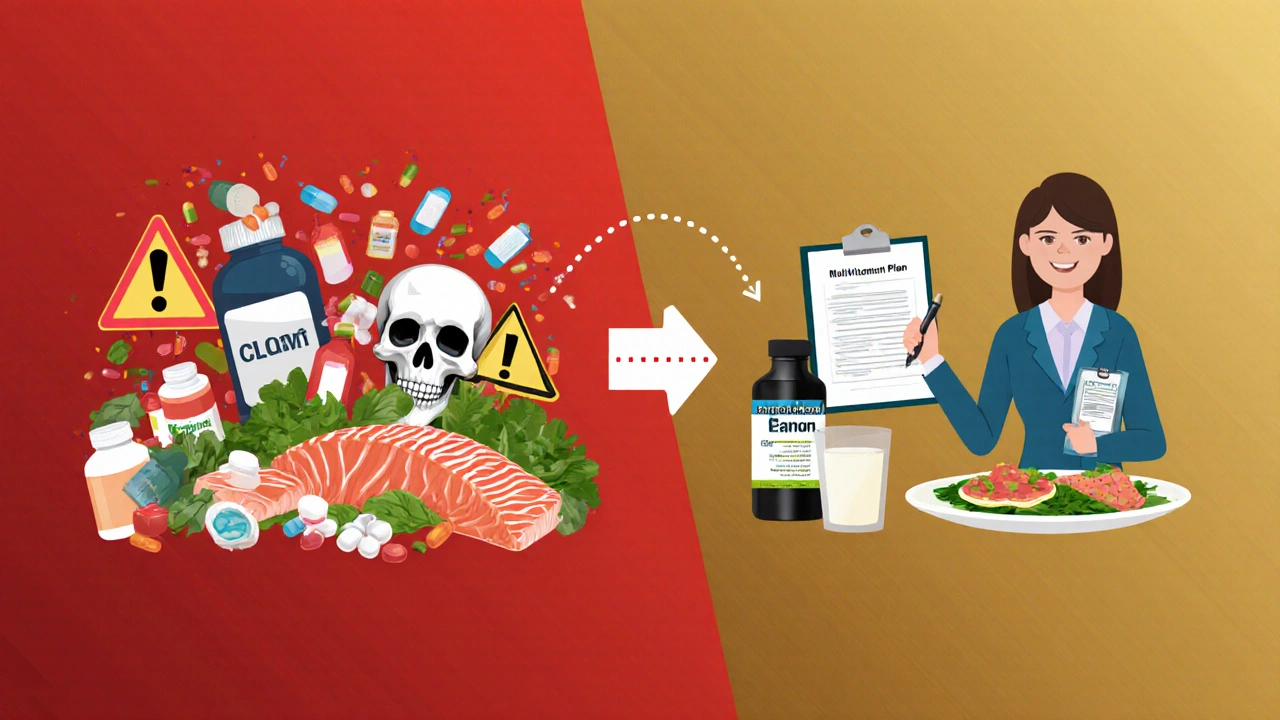Deficiency Risk Assessment Tool
This assessment helps you understand if your symptoms indicate potential vitamin deficiency risks. Remember, this tool is for informational purposes only and does not replace professional medical diagnosis. If you have persistent symptoms, you should consult a healthcare professional.
Risk Assessment Result
Your risk assessment score: 0
Key Takeaways
- Self‑diagnosis often confuses normal fatigue with a serious deficiency.
- Professional blood tests can pinpoint exact vitamin levels with >90% accuracy.
- Incorrect supplementation may cause toxicity or mask underlying health issues.
- See a qualified health professional when symptoms are persistent, severe, or ambiguous.
- Using reputable labs and a clear treatment plan reduces risks and saves money in the long run.
When you start hearing about self-diagnosing vitamin deficiencies, it’s easy to think you can sort it out with a quick Google search. Vitamin deficiency is a condition where the body lacks adequate amounts of essential vitamins, leading to a range of physical and mental signs. The idea feels empowering - you’re taking charge of your health without a waiting room. But the shortcut can hide more danger than it solves.
Why DIY Diagnosis Looks Tempting
Online quizzes, symptom checkers, and Instagram health gurus promise a free verdict in minutes. They often list a handful of vague signs - “low energy,” “dry skin,” “craving sweets” - and match them to a vitamin, then suggest a “quick fix” supplement. The appeal is clear: no appointment, no insurance claim, instant control.
Most people aren’t aware that many health issues share the same symptoms. A tired child could be iron‑deficient, but the same lethargy could also be thyroid‑related, depression, or simply a lack of sleep. That overlap is why the medical community stresses professional testing.
How Vitamins Work and What Deficiency Looks Like
Vitamins are organic compounds the body cannot make in sufficient quantities, so we rely on diet or supplements. Each vitamin plays a specific role - Vitamin D for calcium absorption, B12 for nerve health, Vitamin C for immune function. When levels dip below the normal range, cells can’t perform optimally.
Typical signs include:
- Persistent fatigue or muscle weakness
- Hair loss or brittle nails
- Skin changes - rashes, dryness, hyperpigmentation
- Mood swings, irritability, or difficulty concentrating
- Unexplained weight loss or gain
Notice how broad these are? That’s the first red flag for self‑diagnosis.

Risks of Self‑Diagnosing Vitamin Deficiencies
1. Misinterpretation of Symptoms - You might attribute a headache to low magnesium when it’s actually dehydration.
2. Incorrect Dosage - Some vitamins are safe in small amounts but toxic in large doses (think Vitamin A or D). Over‑supplementation can damage the liver, kidneys, or cause nerve issues.
3. Masking Underlying Conditions - A deficiency could be a symptom of malabsorption, celiac disease, or an autoimmune disorder. Skipping a professional evaluation prolongs the root cause.
4. Financial Waste - Buying “mega‑doses” that you don’t need adds up quickly, especially when they’re not covered by insurance.
5. Interaction with Medications - Certain supplements can interfere with blood thinners, thyroid medication, or chemotherapy.
What a Professional Assessment Looks Like
When you finally book an appointment, the clinician may order a blood test that measures serum levels of key vitamins such as D, B12, folate, and iron‑binding capacity. This is often called a micronutrient panel. Labs use calibrated instruments (e.g., LC‑MS/MS) that detect concentrations down to nanograms per milliliter, delivering a reliability of >90%.
In some cases, the doctor might suggest a clinical laboratory analysis of urine or hair, especially for heavy‑metal exposure or long‑term trace‑element trends. These tests are ordered based on your medical history, current meds, and a focused physical exam.
After the results return, the healthcare professional (often a registered dietitian, GP, or endocrinologist) will interpret the numbers, explain any deficiencies, and design a tailored plan. That plan may include diet changes, a prescription‑strength supplement, or referrals for further investigations.
When to Stop Self‑Diagnosing and Call a Pro
- Symptoms Persist More Than Two Weeks - If fatigue, mood changes, or skin issues linger despite lifestyle tweaks.
- Multiple Symptoms Appear Simultaneously - Overlapping signs increase the chance of a hidden condition.
- Existing Health Conditions - Diabetes, heart disease, or pregnancy demand careful monitoring.
- You're on Prescription Medication - Interactions are a real danger.
- Family History of Nutrient Disorders - Genetic factors can affect absorption.
Even if you’re confident you know which vitamin is low, a quick blood test can confirm it and prevent dosage errors.
Tips for a Productive Visit
- Write down every symptom you’ve noticed, no matter how small.
- Bring a list of all supplements, herbal products, and over‑the‑counter meds you’re taking.
- Mention recent diet changes - vegan, keto, or intermittent fasting can affect certain nutrients.
- Ask the clinician which specific tests they recommend and why.
- Request a clear follow‑up timeline - many labs take 5‑7 business days for results.

Common Misconceptions About Supplements
Myth 1: “If a supplement is natural, it’s safe.” Natural compounds can be potent; high‑dose Vitamin D can raise calcium to dangerous levels.
Myth 2: “All supplements are created equal.” Bioavailability varies - a chewable B12 may deliver only 10% of the active form compared to a sublingual tablet.
Myth 3: “I can’t get enough vitamins from food.” Most balanced diets meet daily requirements, but absorption issues (e.g., low stomach acid) may still require testing.
Comparison: Self‑Diagnosis vs Professional Assessment
| Factor | Self‑Diagnosis | Professional Assessment |
|---|---|---|
| Accuracy | Low - relies on vague symptoms | High - lab‑validated measurements |
| Cost (initial) | Cheap - usually free online tools | Moderate - blood panel $80‑$150 (often covered) |
| Time to results | Immediate (but uncertain) | 5‑7 business days for lab report |
| Safety | Risk of overdose or missed diagnosis | Guided dosing, monitoring for side effects |
| Follow‑up | Rarely scheduled | Professional creates a plan and checks progress |
Next Steps if You Suspect a Deficiency
1. Stop buying random high‑dose supplements until you have test results.
2. Schedule a visit with your GP or a registered dietitian. Mention that you want a micronutrient panel.
3. Keep a food diary for a week - it helps the clinician see what you’re actually eating.
4. If the lab shows a deficiency, follow the prescribed supplement schedule exactly. Set a reminder; many people forget on busy days.
5. Re‑test after 3‑6 months to confirm levels have normalized.
Frequently Asked Questions
Can I rely on at‑home test kits for vitamin levels?
At‑home kits can give a rough idea, but they often lack the precision of accredited labs. Results may be affected by sample handling, and many kits don’t measure the full vitamin panel. For accurate diagnosis, a clinician‑ordered blood test remains the gold standard.
What vitamins are most commonly deficient in adults?
Vitamin D tops the list worldwide, followed by B12, iron, folate, and magnesium. Deficiencies often reflect limited sun exposure, strict vegan diets, or chronic gastrointestinal issues.
Is it safe to take a multivitamin while waiting for test results?
A standard daily multivitamin at the Recommended Dietary Allowance (RDA) is generally safe for most adults. However, high‑dose single‑vitamin supplements can cause toxicity, especially for fat‑soluble vitamins (A, D, E, K). If you’re unsure, talk to your healthcare provider before adding any supplement.
How long does it take for a deficiency to improve after treatment?
Recovery time varies by vitamin. Vitamin D levels may rise within weeks of proper dosing, while B12 can take 2‑3 months to normalize. Your clinician will schedule follow‑up labs to track progress.
Do diet changes alone fix most deficiencies?
Often, yes. Incorporating fatty fish, fortified dairy, leafy greens, or legumes can boost vitamin intake. Yet, if absorption is compromised (e.g., due to Crohn’s disease), diet alone may not suffice, and supplements become necessary.



Totally get why people want a quick checklist for vitamins, but it’s easy to miss the bigger picture. A simple symptom list can spark curiosity, yet it’s no substitute for a proper exam. If you’ve been feeling off for a few weeks, jot down everything – sleep, diet, stress – and bring it to your doctor. It’ll make the conversation way smoother.
OMG, the idea of DIY vitamin tests is sooo tempting, but it can backfire big time. You might think you’ve nailed the deficiency, only to end up overdosing on something that looks "natural".
Here’s the low‑down: blood panels give you quantifiable numbers, unlike vague fatigue scores. When you pair that data with a diet history, you can pinpoint whether it’s a true micronutrient shortfall or something else like sleep debt. Also, watch out for drug‑nutrient interactions – some meds zap B‑vitamins right out.
When we embark on the quest to self‑diagnose vitamin deficiencies, we often sail into a sea of anecdotal claims that masquerade as science. The human body is an intricate orchestra, and a single off‑note can be caused by myriad factors ranging from genetics to lifestyle choices. While online tools can highlight potential red flags, they rarely account for absorption issues that arise from gut health or chronic illnesses. Moreover, the overlap of symptoms-fatigue, mood swings, skin changes-makes it perilously easy to misattribute the root cause. In practice, a clinician will order a comprehensive micronutrient panel, which provides a snapshot of serum levels with far greater fidelity than a symptom checklist. This data-driven approach reduces the risk of over‑supplementation, which, paradoxically, can lead to toxicity, especially with fat‑soluble vitamins. Consider also the cost‑benefit analysis: a single lab test may seem pricey but saves you from purchasing a cabinet full of high‑dose supplements that might never be needed. It’s fascinating how societal trends toward “do‑it‑yourself” health can sometimes undermine the very wellness they aim to promote. The most responsible path forward blends self‑awareness with professional validation, ensuring that any supplementation is both necessary and safe. In short, treat the tool as a conversation starter, not a verdict. By respecting the limits of self‑assessment, you empower yourself to seek the right care at the right time.
Great point about lab tests, Chelsea. I’d add that many providers will also review diet patterns first, because addressing food sources can sometimes resolve mild deficiencies without drugs.
Self‑diagnosing without a professional is a moral hazard; it shifts responsibility from evidence‑based medicine to guesswork, which can be dangerous for vulnerable individuals.